University Assessment: Organizational Behavior Unit 12 Report
VerifiedAdded on 2023/04/20
|27
|7862
|453
Report
AI Summary
This report delves into the multifaceted aspects of organizational behavior, examining how organizational culture, politics, and power dynamics influence individual and team performance. It analyzes how these elements can either positively or negatively impact a firm's overall success. The report further evaluates content and process theories of motivation, exploring motivational techniques and their role in achieving organizational goals, with examples provided to illustrate these concepts. The analysis covers the impact of organizational culture on employee behavior, the influence of power structures, and the significance of motivation in driving individual actions and achieving work objectives. The report concludes by synthesizing the findings and emphasizing the interconnectedness of these factors in shaping organizational outcomes.
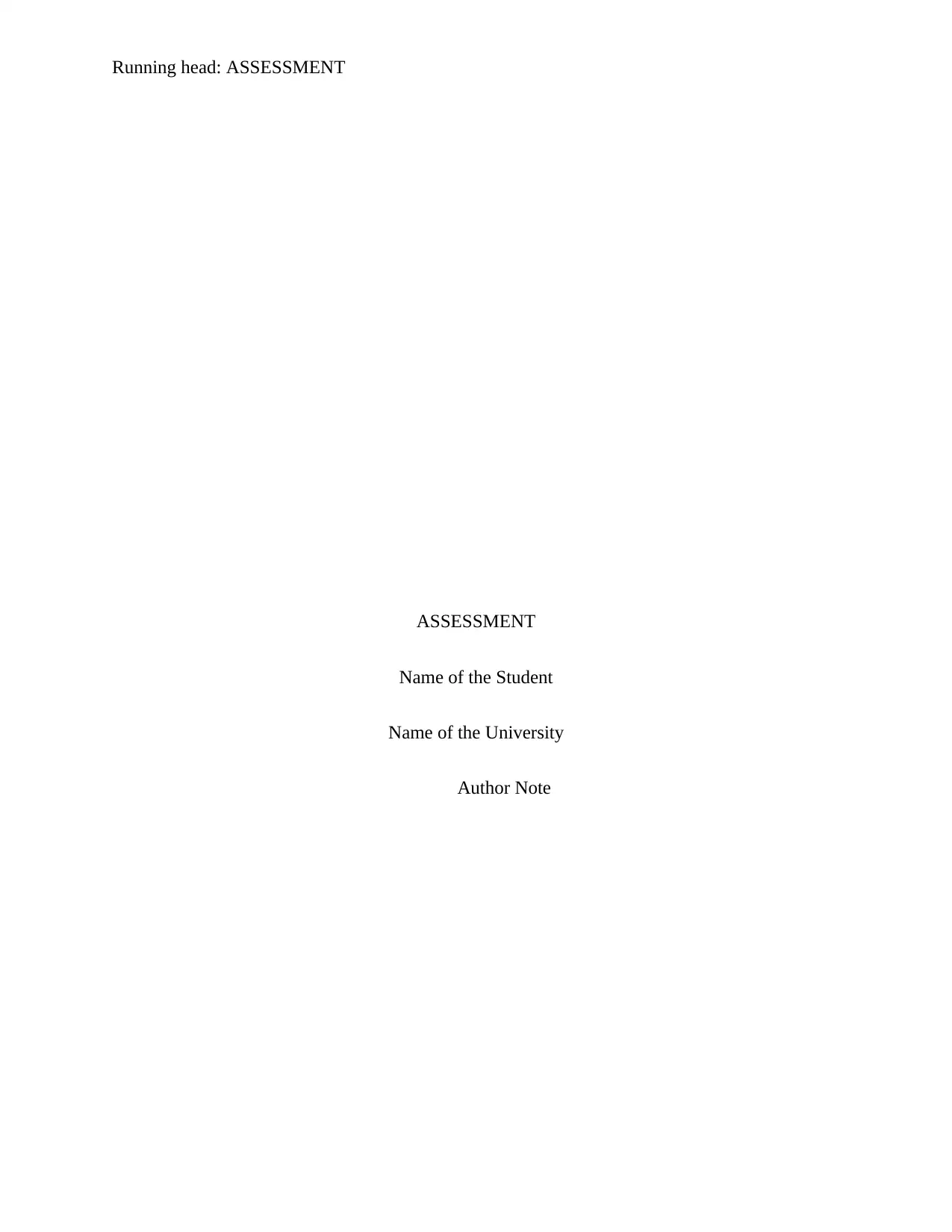
Running head: ASSESSMENT
ASSESSMENT
Name of the Student
Name of the University
Author Note
ASSESSMENT
Name of the Student
Name of the University
Author Note
Paraphrase This Document
Need a fresh take? Get an instant paraphrase of this document with our AI Paraphraser
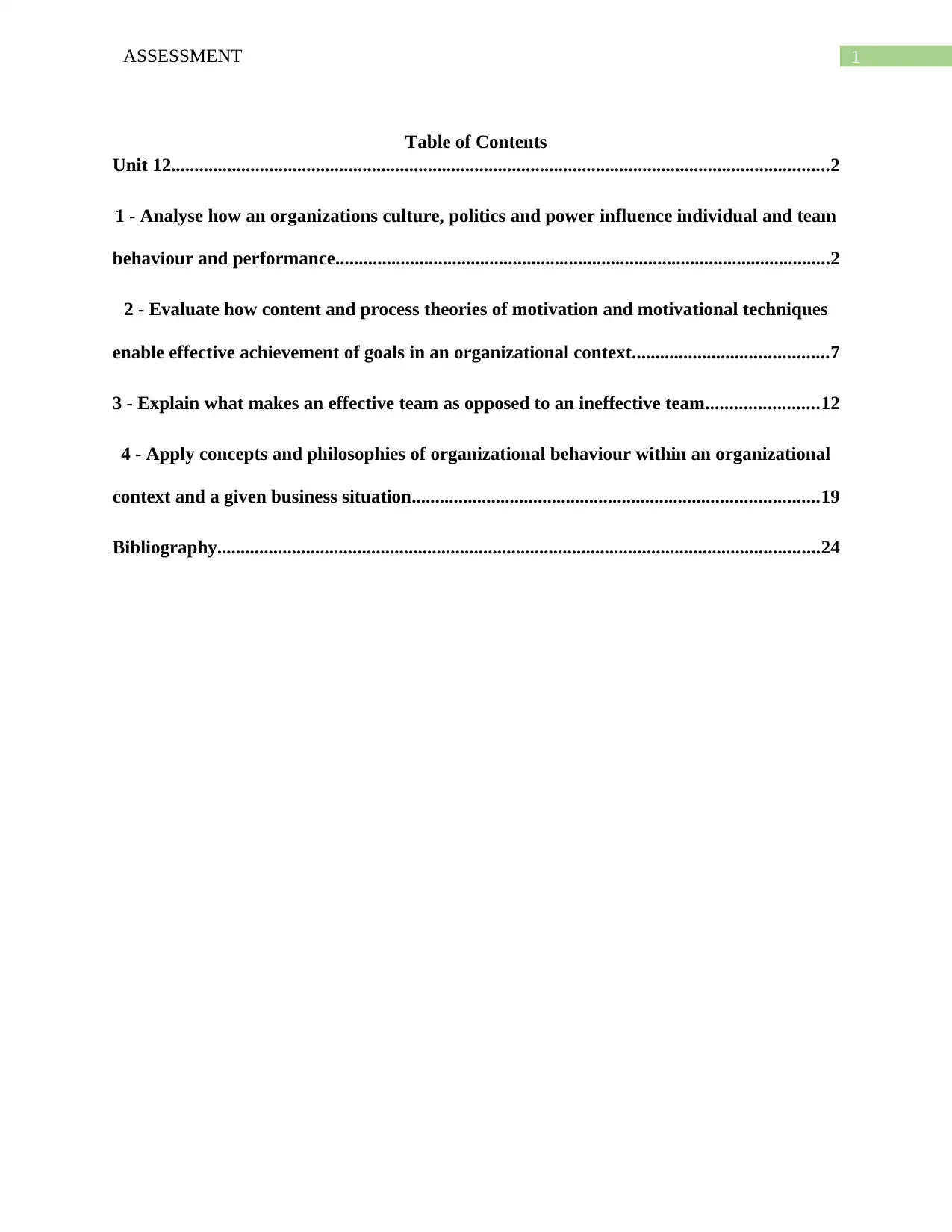
1ASSESSMENT
Table of Contents
Unit 12.............................................................................................................................................2
1 - Analyse how an organizations culture, politics and power influence individual and team
behaviour and performance..........................................................................................................2
2 - Evaluate how content and process theories of motivation and motivational techniques
enable effective achievement of goals in an organizational context..........................................7
3 - Explain what makes an effective team as opposed to an ineffective team........................12
4 - Apply concepts and philosophies of organizational behaviour within an organizational
context and a given business situation.......................................................................................19
Bibliography.................................................................................................................................24
Table of Contents
Unit 12.............................................................................................................................................2
1 - Analyse how an organizations culture, politics and power influence individual and team
behaviour and performance..........................................................................................................2
2 - Evaluate how content and process theories of motivation and motivational techniques
enable effective achievement of goals in an organizational context..........................................7
3 - Explain what makes an effective team as opposed to an ineffective team........................12
4 - Apply concepts and philosophies of organizational behaviour within an organizational
context and a given business situation.......................................................................................19
Bibliography.................................................................................................................................24
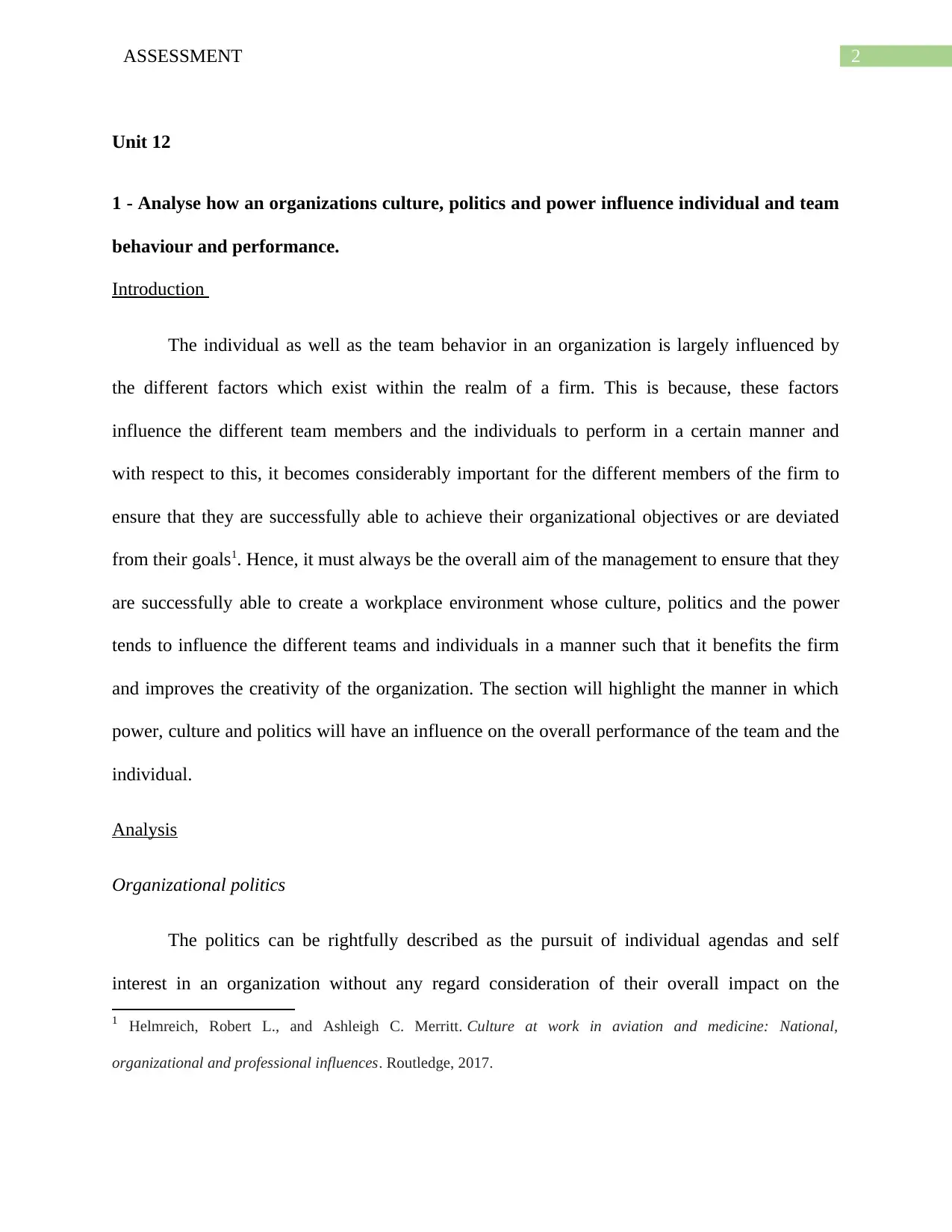
2ASSESSMENT
Unit 12
1 - Analyse how an organizations culture, politics and power influence individual and team
behaviour and performance.
Introduction
The individual as well as the team behavior in an organization is largely influenced by
the different factors which exist within the realm of a firm. This is because, these factors
influence the different team members and the individuals to perform in a certain manner and
with respect to this, it becomes considerably important for the different members of the firm to
ensure that they are successfully able to achieve their organizational objectives or are deviated
from their goals1. Hence, it must always be the overall aim of the management to ensure that they
are successfully able to create a workplace environment whose culture, politics and the power
tends to influence the different teams and individuals in a manner such that it benefits the firm
and improves the creativity of the organization. The section will highlight the manner in which
power, culture and politics will have an influence on the overall performance of the team and the
individual.
Analysis
Organizational politics
The politics can be rightfully described as the pursuit of individual agendas and self
interest in an organization without any regard consideration of their overall impact on the
1 Helmreich, Robert L., and Ashleigh C. Merritt. Culture at work in aviation and medicine: National,
organizational and professional influences. Routledge, 2017.
Unit 12
1 - Analyse how an organizations culture, politics and power influence individual and team
behaviour and performance.
Introduction
The individual as well as the team behavior in an organization is largely influenced by
the different factors which exist within the realm of a firm. This is because, these factors
influence the different team members and the individuals to perform in a certain manner and
with respect to this, it becomes considerably important for the different members of the firm to
ensure that they are successfully able to achieve their organizational objectives or are deviated
from their goals1. Hence, it must always be the overall aim of the management to ensure that they
are successfully able to create a workplace environment whose culture, politics and the power
tends to influence the different teams and individuals in a manner such that it benefits the firm
and improves the creativity of the organization. The section will highlight the manner in which
power, culture and politics will have an influence on the overall performance of the team and the
individual.
Analysis
Organizational politics
The politics can be rightfully described as the pursuit of individual agendas and self
interest in an organization without any regard consideration of their overall impact on the
1 Helmreich, Robert L., and Ashleigh C. Merritt. Culture at work in aviation and medicine: National,
organizational and professional influences. Routledge, 2017.
⊘ This is a preview!⊘
Do you want full access?
Subscribe today to unlock all pages.

Trusted by 1+ million students worldwide
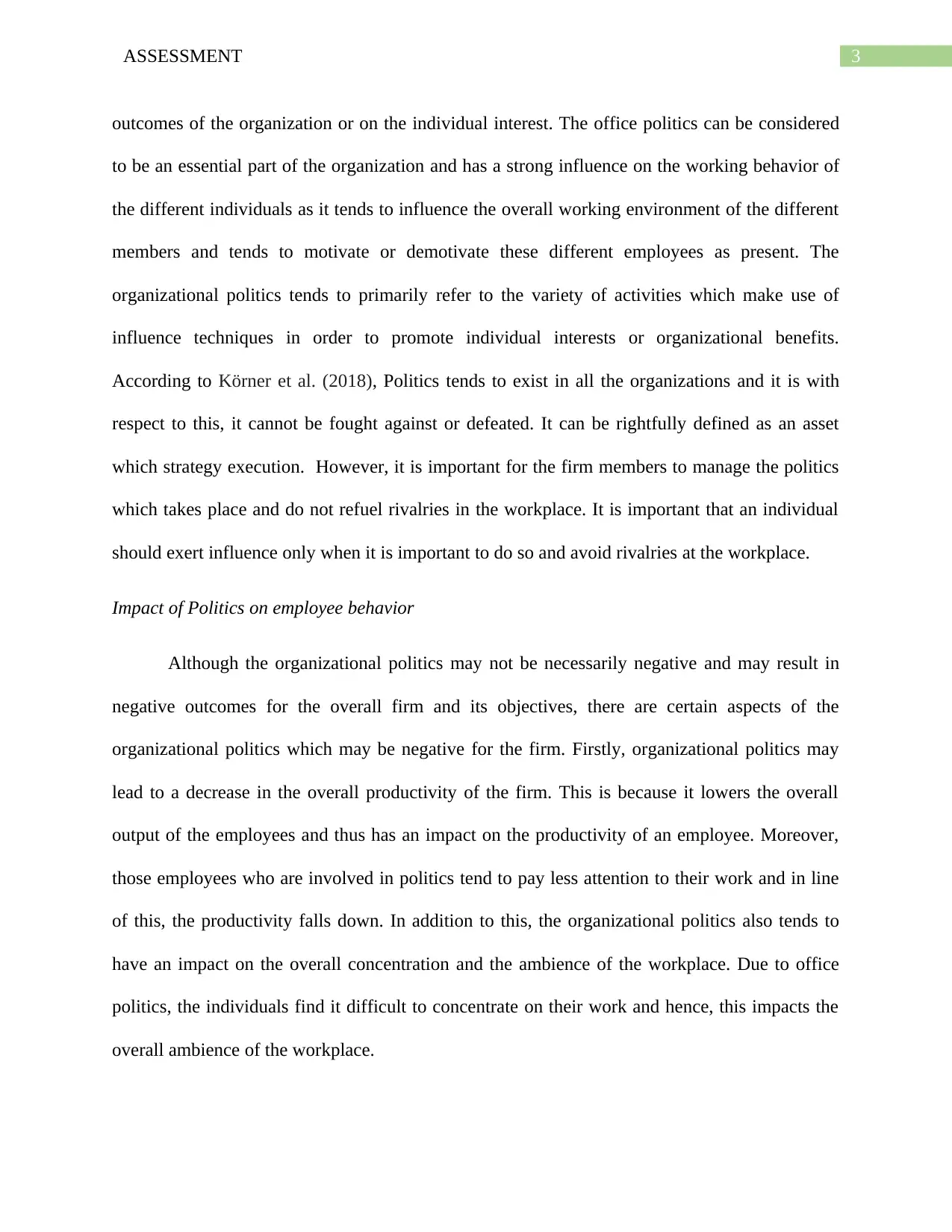
3ASSESSMENT
outcomes of the organization or on the individual interest. The office politics can be considered
to be an essential part of the organization and has a strong influence on the working behavior of
the different individuals as it tends to influence the overall working environment of the different
members and tends to motivate or demotivate these different employees as present. The
organizational politics tends to primarily refer to the variety of activities which make use of
influence techniques in order to promote individual interests or organizational benefits.
According to Körner et al. (2018), Politics tends to exist in all the organizations and it is with
respect to this, it cannot be fought against or defeated. It can be rightfully defined as an asset
which strategy execution. However, it is important for the firm members to manage the politics
which takes place and do not refuel rivalries in the workplace. It is important that an individual
should exert influence only when it is important to do so and avoid rivalries at the workplace.
Impact of Politics on employee behavior
Although the organizational politics may not be necessarily negative and may result in
negative outcomes for the overall firm and its objectives, there are certain aspects of the
organizational politics which may be negative for the firm. Firstly, organizational politics may
lead to a decrease in the overall productivity of the firm. This is because it lowers the overall
output of the employees and thus has an impact on the productivity of an employee. Moreover,
those employees who are involved in politics tend to pay less attention to their work and in line
of this, the productivity falls down. In addition to this, the organizational politics also tends to
have an impact on the overall concentration and the ambience of the workplace. Due to office
politics, the individuals find it difficult to concentrate on their work and hence, this impacts the
overall ambience of the workplace.
outcomes of the organization or on the individual interest. The office politics can be considered
to be an essential part of the organization and has a strong influence on the working behavior of
the different individuals as it tends to influence the overall working environment of the different
members and tends to motivate or demotivate these different employees as present. The
organizational politics tends to primarily refer to the variety of activities which make use of
influence techniques in order to promote individual interests or organizational benefits.
According to Körner et al. (2018), Politics tends to exist in all the organizations and it is with
respect to this, it cannot be fought against or defeated. It can be rightfully defined as an asset
which strategy execution. However, it is important for the firm members to manage the politics
which takes place and do not refuel rivalries in the workplace. It is important that an individual
should exert influence only when it is important to do so and avoid rivalries at the workplace.
Impact of Politics on employee behavior
Although the organizational politics may not be necessarily negative and may result in
negative outcomes for the overall firm and its objectives, there are certain aspects of the
organizational politics which may be negative for the firm. Firstly, organizational politics may
lead to a decrease in the overall productivity of the firm. This is because it lowers the overall
output of the employees and thus has an impact on the productivity of an employee. Moreover,
those employees who are involved in politics tend to pay less attention to their work and in line
of this, the productivity falls down. In addition to this, the organizational politics also tends to
have an impact on the overall concentration and the ambience of the workplace. Due to office
politics, the individuals find it difficult to concentrate on their work and hence, this impacts the
overall ambience of the workplace.
Paraphrase This Document
Need a fresh take? Get an instant paraphrase of this document with our AI Paraphraser
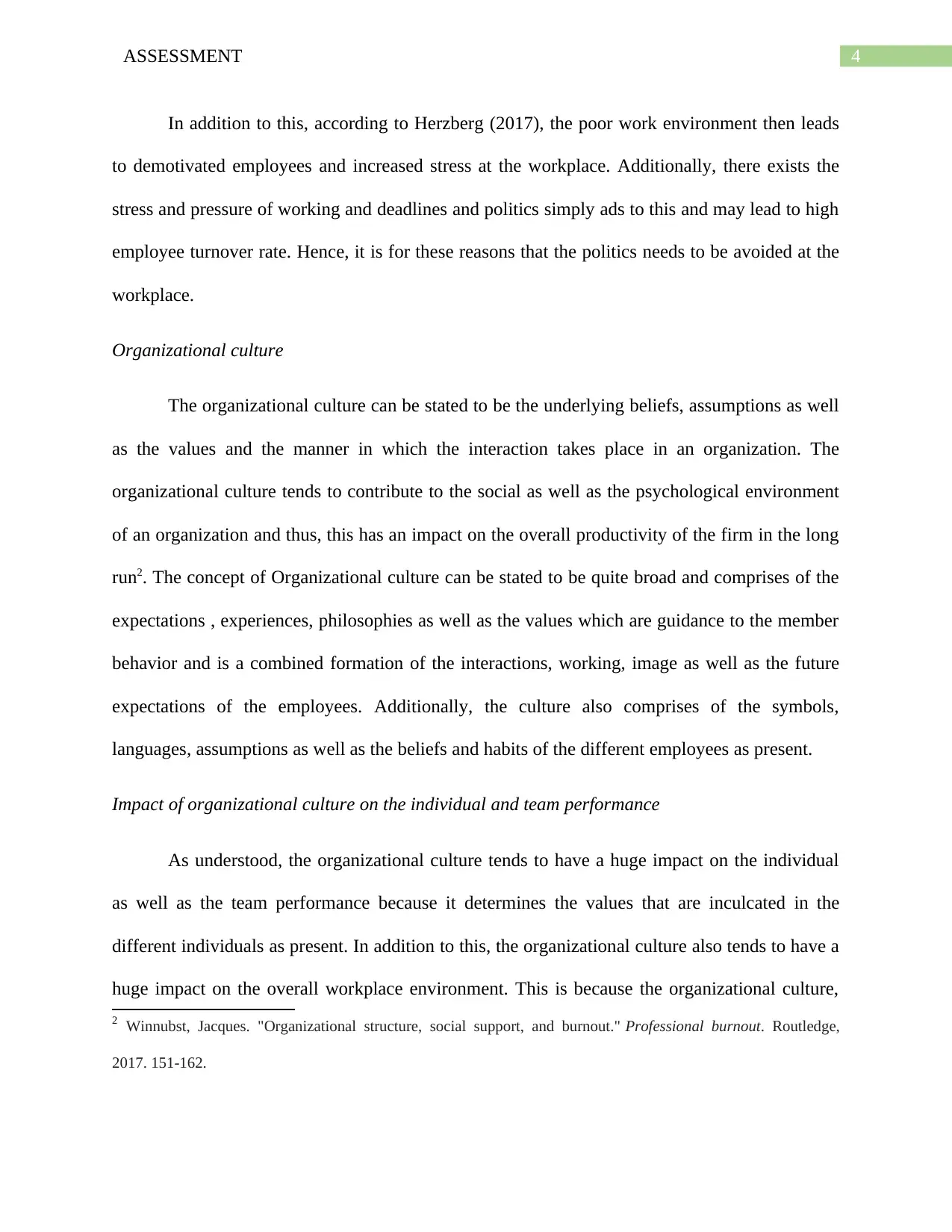
4ASSESSMENT
In addition to this, according to Herzberg (2017), the poor work environment then leads
to demotivated employees and increased stress at the workplace. Additionally, there exists the
stress and pressure of working and deadlines and politics simply ads to this and may lead to high
employee turnover rate. Hence, it is for these reasons that the politics needs to be avoided at the
workplace.
Organizational culture
The organizational culture can be stated to be the underlying beliefs, assumptions as well
as the values and the manner in which the interaction takes place in an organization. The
organizational culture tends to contribute to the social as well as the psychological environment
of an organization and thus, this has an impact on the overall productivity of the firm in the long
run2. The concept of Organizational culture can be stated to be quite broad and comprises of the
expectations , experiences, philosophies as well as the values which are guidance to the member
behavior and is a combined formation of the interactions, working, image as well as the future
expectations of the employees. Additionally, the culture also comprises of the symbols,
languages, assumptions as well as the beliefs and habits of the different employees as present.
Impact of organizational culture on the individual and team performance
As understood, the organizational culture tends to have a huge impact on the individual
as well as the team performance because it determines the values that are inculcated in the
different individuals as present. In addition to this, the organizational culture also tends to have a
huge impact on the overall workplace environment. This is because the organizational culture,
2 Winnubst, Jacques. "Organizational structure, social support, and burnout." Professional burnout. Routledge,
2017. 151-162.
In addition to this, according to Herzberg (2017), the poor work environment then leads
to demotivated employees and increased stress at the workplace. Additionally, there exists the
stress and pressure of working and deadlines and politics simply ads to this and may lead to high
employee turnover rate. Hence, it is for these reasons that the politics needs to be avoided at the
workplace.
Organizational culture
The organizational culture can be stated to be the underlying beliefs, assumptions as well
as the values and the manner in which the interaction takes place in an organization. The
organizational culture tends to contribute to the social as well as the psychological environment
of an organization and thus, this has an impact on the overall productivity of the firm in the long
run2. The concept of Organizational culture can be stated to be quite broad and comprises of the
expectations , experiences, philosophies as well as the values which are guidance to the member
behavior and is a combined formation of the interactions, working, image as well as the future
expectations of the employees. Additionally, the culture also comprises of the symbols,
languages, assumptions as well as the beliefs and habits of the different employees as present.
Impact of organizational culture on the individual and team performance
As understood, the organizational culture tends to have a huge impact on the individual
as well as the team performance because it determines the values that are inculcated in the
different individuals as present. In addition to this, the organizational culture also tends to have a
huge impact on the overall workplace environment. This is because the organizational culture,
2 Winnubst, Jacques. "Organizational structure, social support, and burnout." Professional burnout. Routledge,
2017. 151-162.
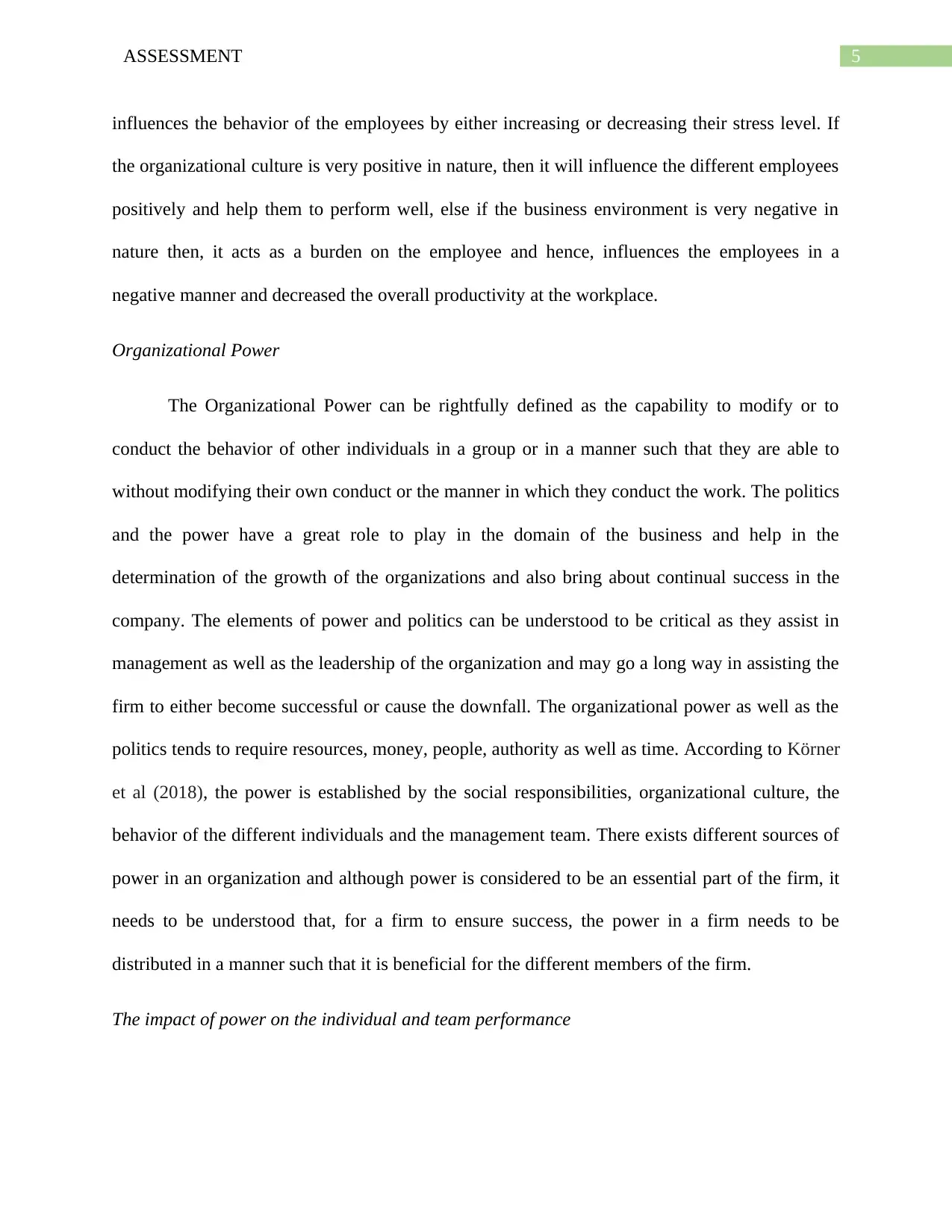
5ASSESSMENT
influences the behavior of the employees by either increasing or decreasing their stress level. If
the organizational culture is very positive in nature, then it will influence the different employees
positively and help them to perform well, else if the business environment is very negative in
nature then, it acts as a burden on the employee and hence, influences the employees in a
negative manner and decreased the overall productivity at the workplace.
Organizational Power
The Organizational Power can be rightfully defined as the capability to modify or to
conduct the behavior of other individuals in a group or in a manner such that they are able to
without modifying their own conduct or the manner in which they conduct the work. The politics
and the power have a great role to play in the domain of the business and help in the
determination of the growth of the organizations and also bring about continual success in the
company. The elements of power and politics can be understood to be critical as they assist in
management as well as the leadership of the organization and may go a long way in assisting the
firm to either become successful or cause the downfall. The organizational power as well as the
politics tends to require resources, money, people, authority as well as time. According to Körner
et al (2018), the power is established by the social responsibilities, organizational culture, the
behavior of the different individuals and the management team. There exists different sources of
power in an organization and although power is considered to be an essential part of the firm, it
needs to be understood that, for a firm to ensure success, the power in a firm needs to be
distributed in a manner such that it is beneficial for the different members of the firm.
The impact of power on the individual and team performance
influences the behavior of the employees by either increasing or decreasing their stress level. If
the organizational culture is very positive in nature, then it will influence the different employees
positively and help them to perform well, else if the business environment is very negative in
nature then, it acts as a burden on the employee and hence, influences the employees in a
negative manner and decreased the overall productivity at the workplace.
Organizational Power
The Organizational Power can be rightfully defined as the capability to modify or to
conduct the behavior of other individuals in a group or in a manner such that they are able to
without modifying their own conduct or the manner in which they conduct the work. The politics
and the power have a great role to play in the domain of the business and help in the
determination of the growth of the organizations and also bring about continual success in the
company. The elements of power and politics can be understood to be critical as they assist in
management as well as the leadership of the organization and may go a long way in assisting the
firm to either become successful or cause the downfall. The organizational power as well as the
politics tends to require resources, money, people, authority as well as time. According to Körner
et al (2018), the power is established by the social responsibilities, organizational culture, the
behavior of the different individuals and the management team. There exists different sources of
power in an organization and although power is considered to be an essential part of the firm, it
needs to be understood that, for a firm to ensure success, the power in a firm needs to be
distributed in a manner such that it is beneficial for the different members of the firm.
The impact of power on the individual and team performance
⊘ This is a preview!⊘
Do you want full access?
Subscribe today to unlock all pages.

Trusted by 1+ million students worldwide
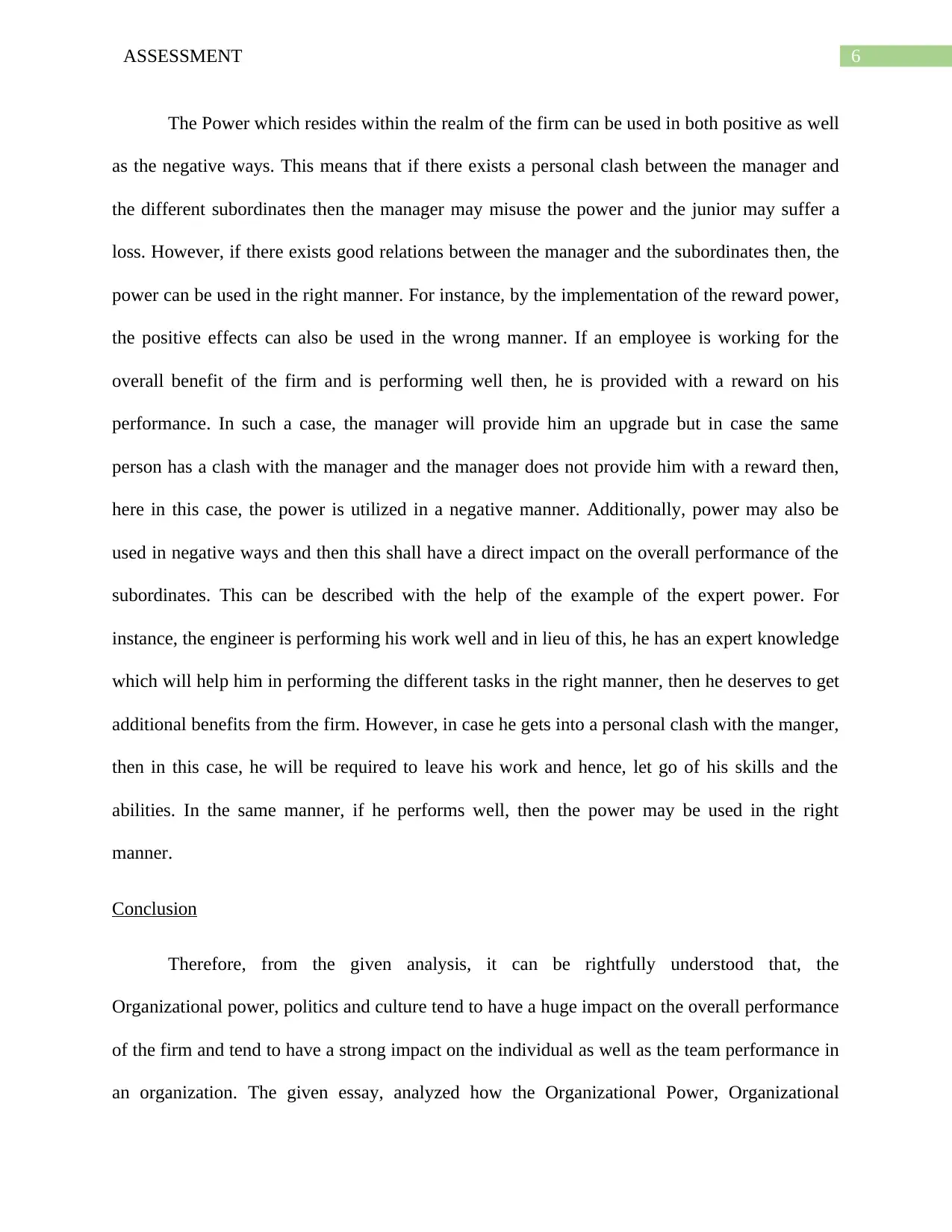
6ASSESSMENT
The Power which resides within the realm of the firm can be used in both positive as well
as the negative ways. This means that if there exists a personal clash between the manager and
the different subordinates then the manager may misuse the power and the junior may suffer a
loss. However, if there exists good relations between the manager and the subordinates then, the
power can be used in the right manner. For instance, by the implementation of the reward power,
the positive effects can also be used in the wrong manner. If an employee is working for the
overall benefit of the firm and is performing well then, he is provided with a reward on his
performance. In such a case, the manager will provide him an upgrade but in case the same
person has a clash with the manager and the manager does not provide him with a reward then,
here in this case, the power is utilized in a negative manner. Additionally, power may also be
used in negative ways and then this shall have a direct impact on the overall performance of the
subordinates. This can be described with the help of the example of the expert power. For
instance, the engineer is performing his work well and in lieu of this, he has an expert knowledge
which will help him in performing the different tasks in the right manner, then he deserves to get
additional benefits from the firm. However, in case he gets into a personal clash with the manger,
then in this case, he will be required to leave his work and hence, let go of his skills and the
abilities. In the same manner, if he performs well, then the power may be used in the right
manner.
Conclusion
Therefore, from the given analysis, it can be rightfully understood that, the
Organizational power, politics and culture tend to have a huge impact on the overall performance
of the firm and tend to have a strong impact on the individual as well as the team performance in
an organization. The given essay, analyzed how the Organizational Power, Organizational
The Power which resides within the realm of the firm can be used in both positive as well
as the negative ways. This means that if there exists a personal clash between the manager and
the different subordinates then the manager may misuse the power and the junior may suffer a
loss. However, if there exists good relations between the manager and the subordinates then, the
power can be used in the right manner. For instance, by the implementation of the reward power,
the positive effects can also be used in the wrong manner. If an employee is working for the
overall benefit of the firm and is performing well then, he is provided with a reward on his
performance. In such a case, the manager will provide him an upgrade but in case the same
person has a clash with the manager and the manager does not provide him with a reward then,
here in this case, the power is utilized in a negative manner. Additionally, power may also be
used in negative ways and then this shall have a direct impact on the overall performance of the
subordinates. This can be described with the help of the example of the expert power. For
instance, the engineer is performing his work well and in lieu of this, he has an expert knowledge
which will help him in performing the different tasks in the right manner, then he deserves to get
additional benefits from the firm. However, in case he gets into a personal clash with the manger,
then in this case, he will be required to leave his work and hence, let go of his skills and the
abilities. In the same manner, if he performs well, then the power may be used in the right
manner.
Conclusion
Therefore, from the given analysis, it can be rightfully understood that, the
Organizational power, politics and culture tend to have a huge impact on the overall performance
of the firm and tend to have a strong impact on the individual as well as the team performance in
an organization. The given essay, analyzed how the Organizational Power, Organizational
Paraphrase This Document
Need a fresh take? Get an instant paraphrase of this document with our AI Paraphraser
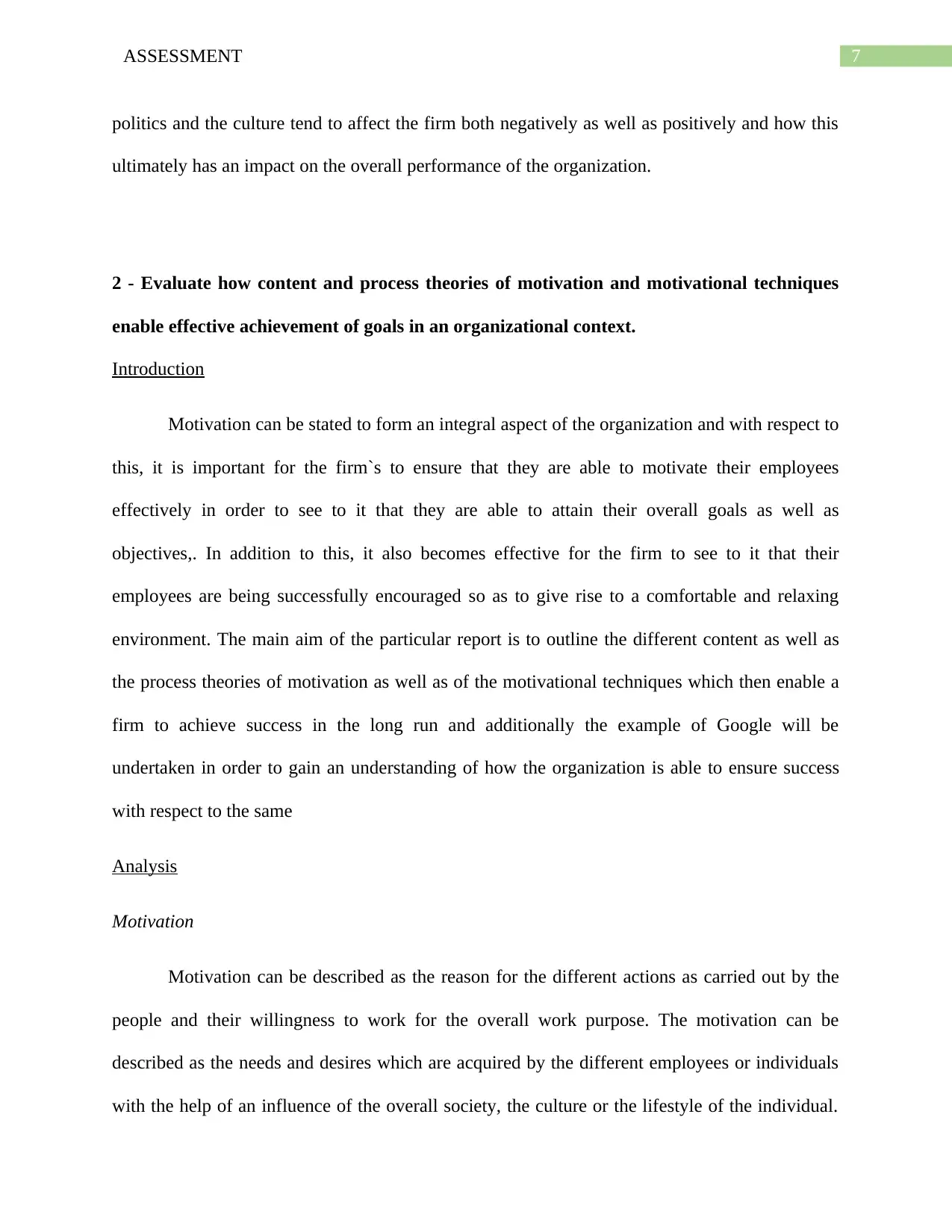
7ASSESSMENT
politics and the culture tend to affect the firm both negatively as well as positively and how this
ultimately has an impact on the overall performance of the organization.
2 - Evaluate how content and process theories of motivation and motivational techniques
enable effective achievement of goals in an organizational context.
Introduction
Motivation can be stated to form an integral aspect of the organization and with respect to
this, it is important for the firm`s to ensure that they are able to motivate their employees
effectively in order to see to it that they are able to attain their overall goals as well as
objectives,. In addition to this, it also becomes effective for the firm to see to it that their
employees are being successfully encouraged so as to give rise to a comfortable and relaxing
environment. The main aim of the particular report is to outline the different content as well as
the process theories of motivation as well as of the motivational techniques which then enable a
firm to achieve success in the long run and additionally the example of Google will be
undertaken in order to gain an understanding of how the organization is able to ensure success
with respect to the same
Analysis
Motivation
Motivation can be described as the reason for the different actions as carried out by the
people and their willingness to work for the overall work purpose. The motivation can be
described as the needs and desires which are acquired by the different employees or individuals
with the help of an influence of the overall society, the culture or the lifestyle of the individual.
politics and the culture tend to affect the firm both negatively as well as positively and how this
ultimately has an impact on the overall performance of the organization.
2 - Evaluate how content and process theories of motivation and motivational techniques
enable effective achievement of goals in an organizational context.
Introduction
Motivation can be stated to form an integral aspect of the organization and with respect to
this, it is important for the firm`s to ensure that they are able to motivate their employees
effectively in order to see to it that they are able to attain their overall goals as well as
objectives,. In addition to this, it also becomes effective for the firm to see to it that their
employees are being successfully encouraged so as to give rise to a comfortable and relaxing
environment. The main aim of the particular report is to outline the different content as well as
the process theories of motivation as well as of the motivational techniques which then enable a
firm to achieve success in the long run and additionally the example of Google will be
undertaken in order to gain an understanding of how the organization is able to ensure success
with respect to the same
Analysis
Motivation
Motivation can be described as the reason for the different actions as carried out by the
people and their willingness to work for the overall work purpose. The motivation can be
described as the needs and desires which are acquired by the different employees or individuals
with the help of an influence of the overall society, the culture or the lifestyle of the individual.
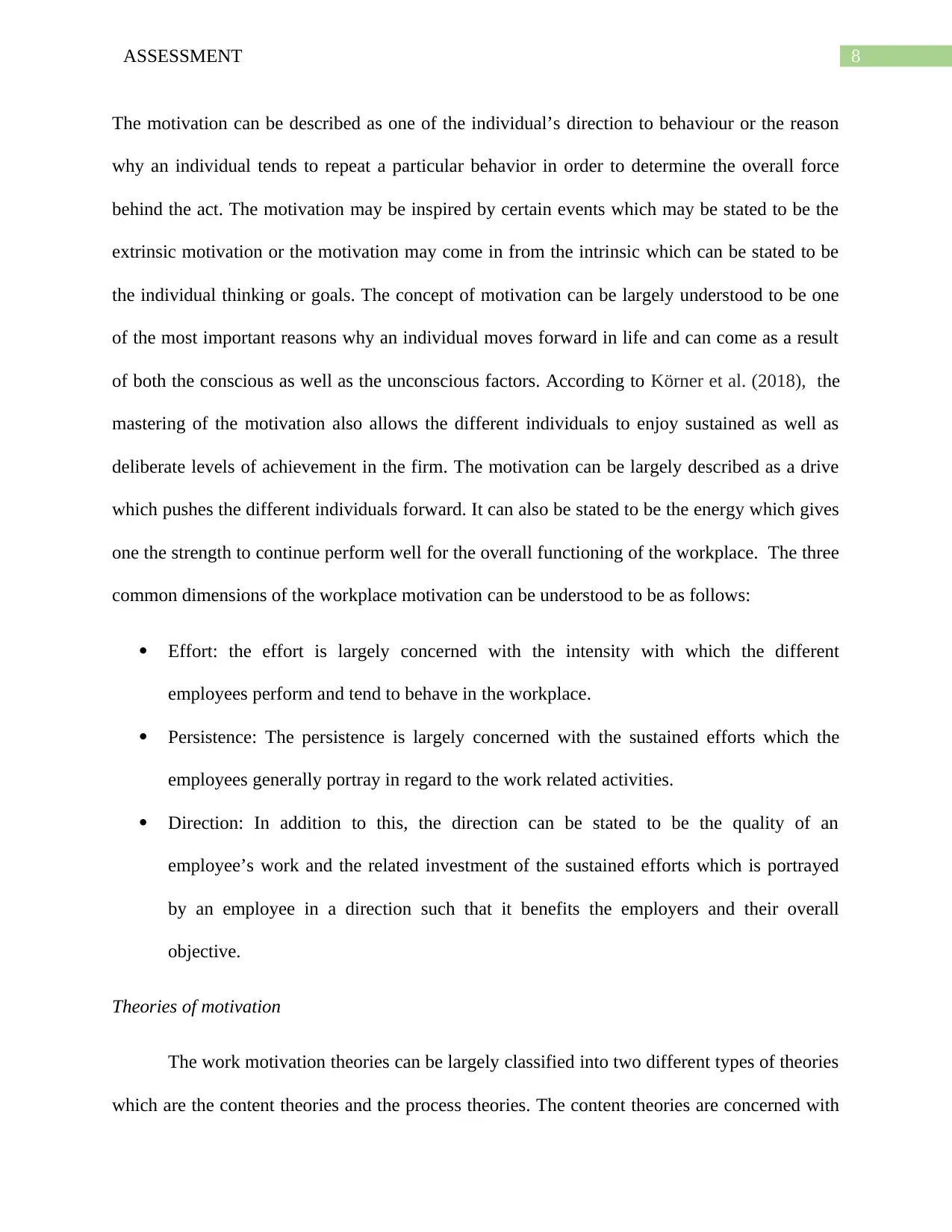
8ASSESSMENT
The motivation can be described as one of the individual’s direction to behaviour or the reason
why an individual tends to repeat a particular behavior in order to determine the overall force
behind the act. The motivation may be inspired by certain events which may be stated to be the
extrinsic motivation or the motivation may come in from the intrinsic which can be stated to be
the individual thinking or goals. The concept of motivation can be largely understood to be one
of the most important reasons why an individual moves forward in life and can come as a result
of both the conscious as well as the unconscious factors. According to Körner et al. (2018), the
mastering of the motivation also allows the different individuals to enjoy sustained as well as
deliberate levels of achievement in the firm. The motivation can be largely described as a drive
which pushes the different individuals forward. It can also be stated to be the energy which gives
one the strength to continue perform well for the overall functioning of the workplace. The three
common dimensions of the workplace motivation can be understood to be as follows:
Effort: the effort is largely concerned with the intensity with which the different
employees perform and tend to behave in the workplace.
Persistence: The persistence is largely concerned with the sustained efforts which the
employees generally portray in regard to the work related activities.
Direction: In addition to this, the direction can be stated to be the quality of an
employee’s work and the related investment of the sustained efforts which is portrayed
by an employee in a direction such that it benefits the employers and their overall
objective.
Theories of motivation
The work motivation theories can be largely classified into two different types of theories
which are the content theories and the process theories. The content theories are concerned with
The motivation can be described as one of the individual’s direction to behaviour or the reason
why an individual tends to repeat a particular behavior in order to determine the overall force
behind the act. The motivation may be inspired by certain events which may be stated to be the
extrinsic motivation or the motivation may come in from the intrinsic which can be stated to be
the individual thinking or goals. The concept of motivation can be largely understood to be one
of the most important reasons why an individual moves forward in life and can come as a result
of both the conscious as well as the unconscious factors. According to Körner et al. (2018), the
mastering of the motivation also allows the different individuals to enjoy sustained as well as
deliberate levels of achievement in the firm. The motivation can be largely described as a drive
which pushes the different individuals forward. It can also be stated to be the energy which gives
one the strength to continue perform well for the overall functioning of the workplace. The three
common dimensions of the workplace motivation can be understood to be as follows:
Effort: the effort is largely concerned with the intensity with which the different
employees perform and tend to behave in the workplace.
Persistence: The persistence is largely concerned with the sustained efforts which the
employees generally portray in regard to the work related activities.
Direction: In addition to this, the direction can be stated to be the quality of an
employee’s work and the related investment of the sustained efforts which is portrayed
by an employee in a direction such that it benefits the employers and their overall
objective.
Theories of motivation
The work motivation theories can be largely classified into two different types of theories
which are the content theories and the process theories. The content theories are concerned with
⊘ This is a preview!⊘
Do you want full access?
Subscribe today to unlock all pages.

Trusted by 1+ million students worldwide
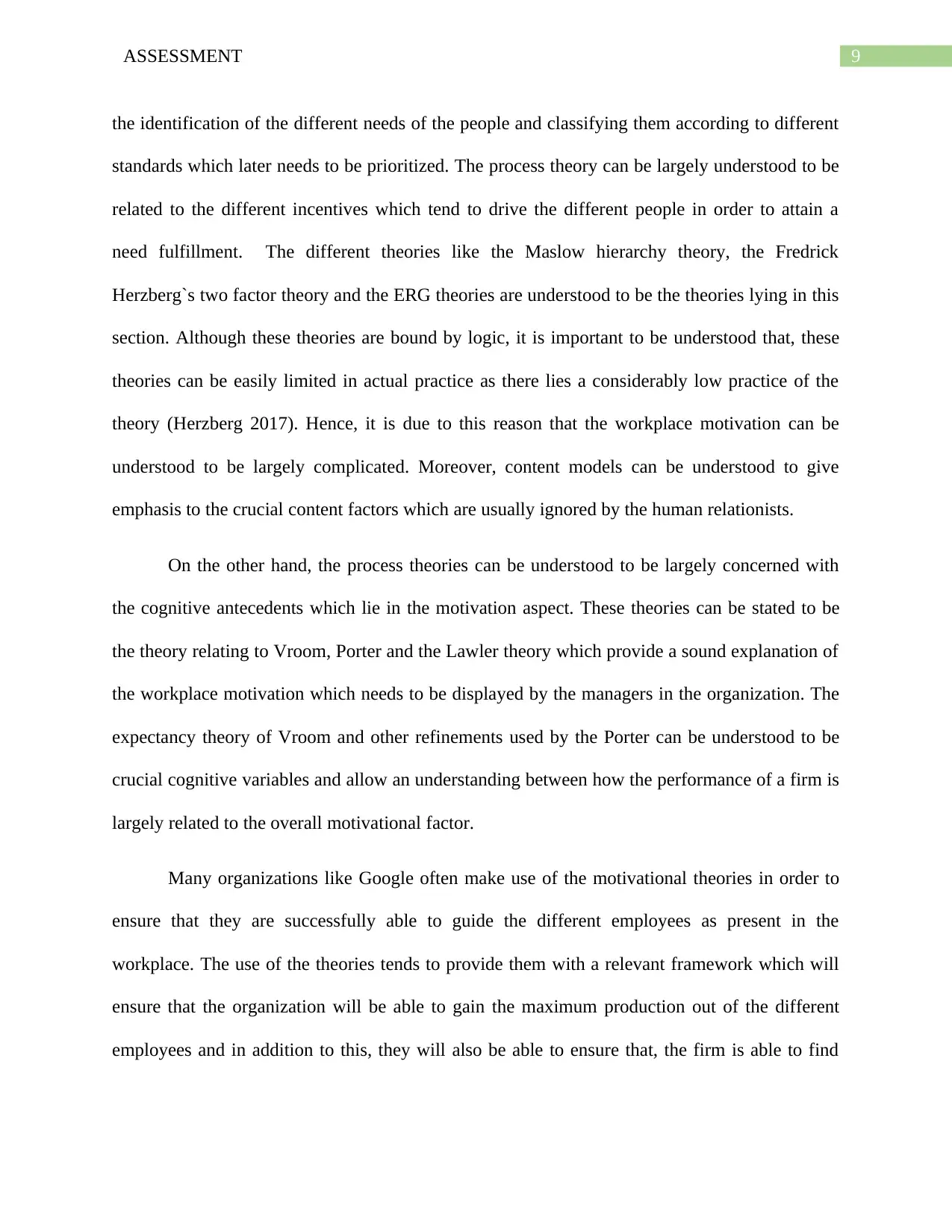
9ASSESSMENT
the identification of the different needs of the people and classifying them according to different
standards which later needs to be prioritized. The process theory can be largely understood to be
related to the different incentives which tend to drive the different people in order to attain a
need fulfillment. The different theories like the Maslow hierarchy theory, the Fredrick
Herzberg`s two factor theory and the ERG theories are understood to be the theories lying in this
section. Although these theories are bound by logic, it is important to be understood that, these
theories can be easily limited in actual practice as there lies a considerably low practice of the
theory (Herzberg 2017). Hence, it is due to this reason that the workplace motivation can be
understood to be largely complicated. Moreover, content models can be understood to give
emphasis to the crucial content factors which are usually ignored by the human relationists.
On the other hand, the process theories can be understood to be largely concerned with
the cognitive antecedents which lie in the motivation aspect. These theories can be stated to be
the theory relating to Vroom, Porter and the Lawler theory which provide a sound explanation of
the workplace motivation which needs to be displayed by the managers in the organization. The
expectancy theory of Vroom and other refinements used by the Porter can be understood to be
crucial cognitive variables and allow an understanding between how the performance of a firm is
largely related to the overall motivational factor.
Many organizations like Google often make use of the motivational theories in order to
ensure that they are successfully able to guide the different employees as present in the
workplace. The use of the theories tends to provide them with a relevant framework which will
ensure that the organization will be able to gain the maximum production out of the different
employees and in addition to this, they will also be able to ensure that, the firm is able to find
the identification of the different needs of the people and classifying them according to different
standards which later needs to be prioritized. The process theory can be largely understood to be
related to the different incentives which tend to drive the different people in order to attain a
need fulfillment. The different theories like the Maslow hierarchy theory, the Fredrick
Herzberg`s two factor theory and the ERG theories are understood to be the theories lying in this
section. Although these theories are bound by logic, it is important to be understood that, these
theories can be easily limited in actual practice as there lies a considerably low practice of the
theory (Herzberg 2017). Hence, it is due to this reason that the workplace motivation can be
understood to be largely complicated. Moreover, content models can be understood to give
emphasis to the crucial content factors which are usually ignored by the human relationists.
On the other hand, the process theories can be understood to be largely concerned with
the cognitive antecedents which lie in the motivation aspect. These theories can be stated to be
the theory relating to Vroom, Porter and the Lawler theory which provide a sound explanation of
the workplace motivation which needs to be displayed by the managers in the organization. The
expectancy theory of Vroom and other refinements used by the Porter can be understood to be
crucial cognitive variables and allow an understanding between how the performance of a firm is
largely related to the overall motivational factor.
Many organizations like Google often make use of the motivational theories in order to
ensure that they are successfully able to guide the different employees as present in the
workplace. The use of the theories tends to provide them with a relevant framework which will
ensure that the organization will be able to gain the maximum production out of the different
employees and in addition to this, they will also be able to ensure that, the firm is able to find
Paraphrase This Document
Need a fresh take? Get an instant paraphrase of this document with our AI Paraphraser
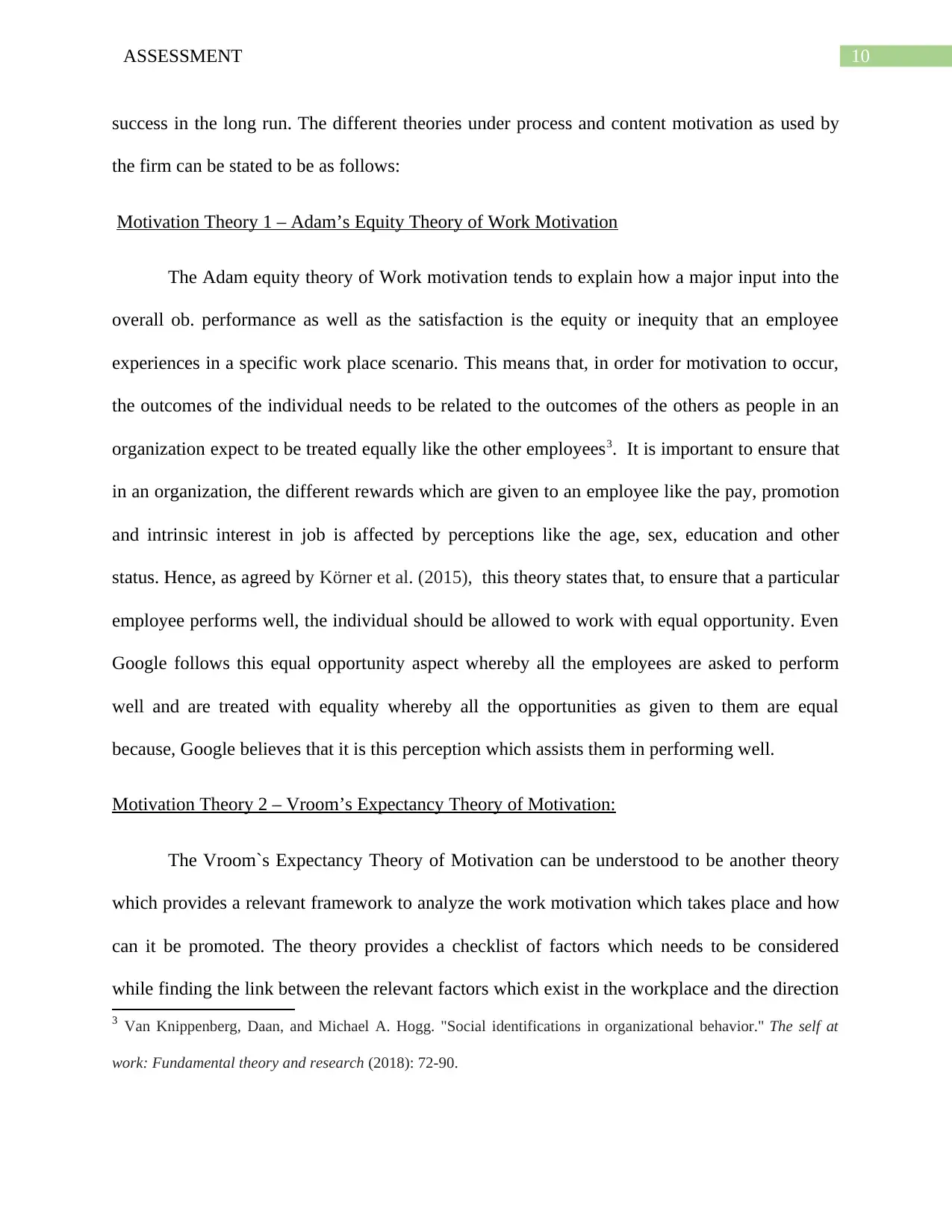
10ASSESSMENT
success in the long run. The different theories under process and content motivation as used by
the firm can be stated to be as follows:
Motivation Theory 1 – Adam’s Equity Theory of Work Motivation
The Adam equity theory of Work motivation tends to explain how a major input into the
overall ob. performance as well as the satisfaction is the equity or inequity that an employee
experiences in a specific work place scenario. This means that, in order for motivation to occur,
the outcomes of the individual needs to be related to the outcomes of the others as people in an
organization expect to be treated equally like the other employees3. It is important to ensure that
in an organization, the different rewards which are given to an employee like the pay, promotion
and intrinsic interest in job is affected by perceptions like the age, sex, education and other
status. Hence, as agreed by Körner et al. (2015), this theory states that, to ensure that a particular
employee performs well, the individual should be allowed to work with equal opportunity. Even
Google follows this equal opportunity aspect whereby all the employees are asked to perform
well and are treated with equality whereby all the opportunities as given to them are equal
because, Google believes that it is this perception which assists them in performing well.
Motivation Theory 2 – Vroom’s Expectancy Theory of Motivation:
The Vroom`s Expectancy Theory of Motivation can be understood to be another theory
which provides a relevant framework to analyze the work motivation which takes place and how
can it be promoted. The theory provides a checklist of factors which needs to be considered
while finding the link between the relevant factors which exist in the workplace and the direction
3 Van Knippenberg, Daan, and Michael A. Hogg. "Social identifications in organizational behavior." The self at
work: Fundamental theory and research (2018): 72-90.
success in the long run. The different theories under process and content motivation as used by
the firm can be stated to be as follows:
Motivation Theory 1 – Adam’s Equity Theory of Work Motivation
The Adam equity theory of Work motivation tends to explain how a major input into the
overall ob. performance as well as the satisfaction is the equity or inequity that an employee
experiences in a specific work place scenario. This means that, in order for motivation to occur,
the outcomes of the individual needs to be related to the outcomes of the others as people in an
organization expect to be treated equally like the other employees3. It is important to ensure that
in an organization, the different rewards which are given to an employee like the pay, promotion
and intrinsic interest in job is affected by perceptions like the age, sex, education and other
status. Hence, as agreed by Körner et al. (2015), this theory states that, to ensure that a particular
employee performs well, the individual should be allowed to work with equal opportunity. Even
Google follows this equal opportunity aspect whereby all the employees are asked to perform
well and are treated with equality whereby all the opportunities as given to them are equal
because, Google believes that it is this perception which assists them in performing well.
Motivation Theory 2 – Vroom’s Expectancy Theory of Motivation:
The Vroom`s Expectancy Theory of Motivation can be understood to be another theory
which provides a relevant framework to analyze the work motivation which takes place and how
can it be promoted. The theory provides a checklist of factors which needs to be considered
while finding the link between the relevant factors which exist in the workplace and the direction
3 Van Knippenberg, Daan, and Michael A. Hogg. "Social identifications in organizational behavior." The self at
work: Fundamental theory and research (2018): 72-90.
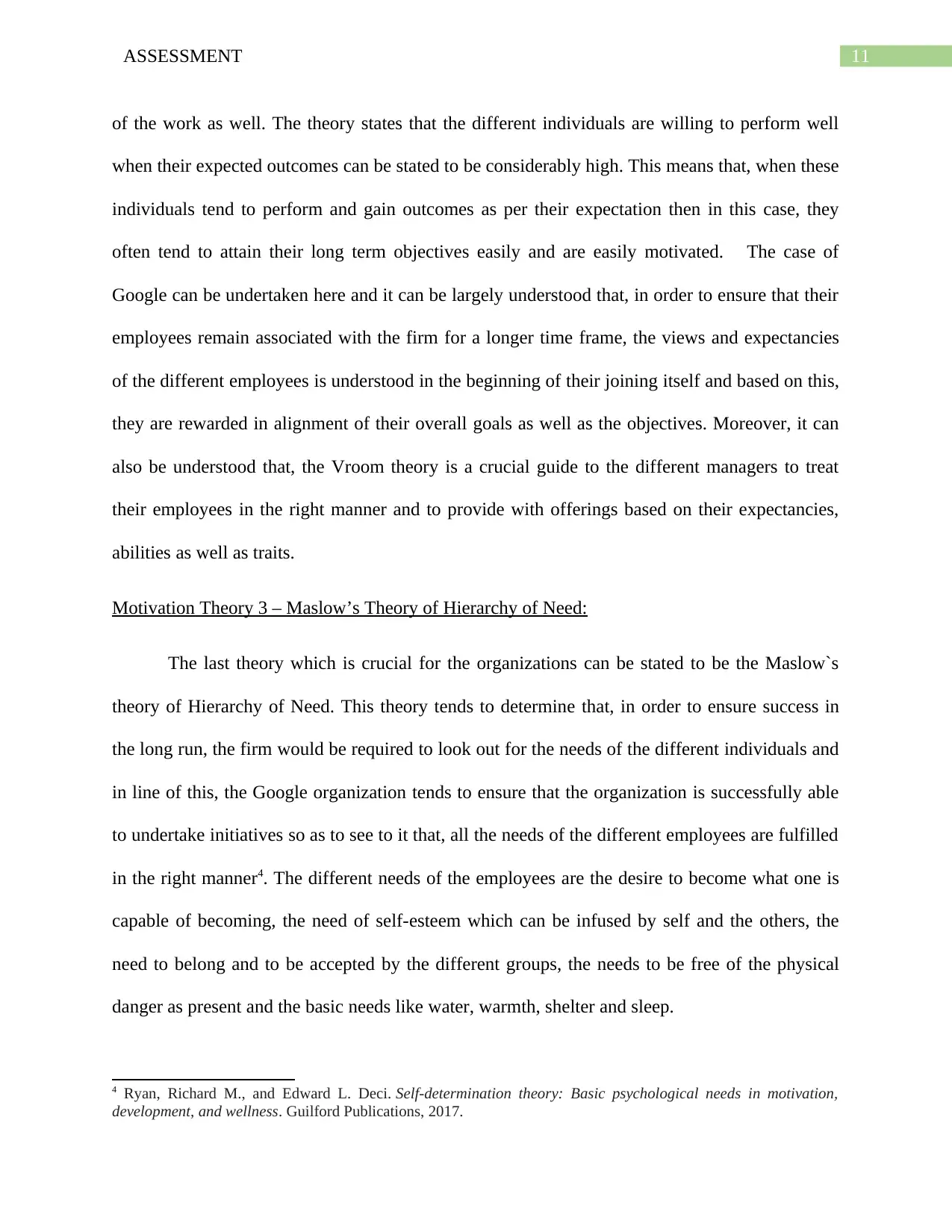
11ASSESSMENT
of the work as well. The theory states that the different individuals are willing to perform well
when their expected outcomes can be stated to be considerably high. This means that, when these
individuals tend to perform and gain outcomes as per their expectation then in this case, they
often tend to attain their long term objectives easily and are easily motivated. The case of
Google can be undertaken here and it can be largely understood that, in order to ensure that their
employees remain associated with the firm for a longer time frame, the views and expectancies
of the different employees is understood in the beginning of their joining itself and based on this,
they are rewarded in alignment of their overall goals as well as the objectives. Moreover, it can
also be understood that, the Vroom theory is a crucial guide to the different managers to treat
their employees in the right manner and to provide with offerings based on their expectancies,
abilities as well as traits.
Motivation Theory 3 – Maslow’s Theory of Hierarchy of Need:
The last theory which is crucial for the organizations can be stated to be the Maslow`s
theory of Hierarchy of Need. This theory tends to determine that, in order to ensure success in
the long run, the firm would be required to look out for the needs of the different individuals and
in line of this, the Google organization tends to ensure that the organization is successfully able
to undertake initiatives so as to see to it that, all the needs of the different employees are fulfilled
in the right manner4. The different needs of the employees are the desire to become what one is
capable of becoming, the need of self-esteem which can be infused by self and the others, the
need to belong and to be accepted by the different groups, the needs to be free of the physical
danger as present and the basic needs like water, warmth, shelter and sleep.
4 Ryan, Richard M., and Edward L. Deci. Self-determination theory: Basic psychological needs in motivation,
development, and wellness. Guilford Publications, 2017.
of the work as well. The theory states that the different individuals are willing to perform well
when their expected outcomes can be stated to be considerably high. This means that, when these
individuals tend to perform and gain outcomes as per their expectation then in this case, they
often tend to attain their long term objectives easily and are easily motivated. The case of
Google can be undertaken here and it can be largely understood that, in order to ensure that their
employees remain associated with the firm for a longer time frame, the views and expectancies
of the different employees is understood in the beginning of their joining itself and based on this,
they are rewarded in alignment of their overall goals as well as the objectives. Moreover, it can
also be understood that, the Vroom theory is a crucial guide to the different managers to treat
their employees in the right manner and to provide with offerings based on their expectancies,
abilities as well as traits.
Motivation Theory 3 – Maslow’s Theory of Hierarchy of Need:
The last theory which is crucial for the organizations can be stated to be the Maslow`s
theory of Hierarchy of Need. This theory tends to determine that, in order to ensure success in
the long run, the firm would be required to look out for the needs of the different individuals and
in line of this, the Google organization tends to ensure that the organization is successfully able
to undertake initiatives so as to see to it that, all the needs of the different employees are fulfilled
in the right manner4. The different needs of the employees are the desire to become what one is
capable of becoming, the need of self-esteem which can be infused by self and the others, the
need to belong and to be accepted by the different groups, the needs to be free of the physical
danger as present and the basic needs like water, warmth, shelter and sleep.
4 Ryan, Richard M., and Edward L. Deci. Self-determination theory: Basic psychological needs in motivation,
development, and wellness. Guilford Publications, 2017.
⊘ This is a preview!⊘
Do you want full access?
Subscribe today to unlock all pages.

Trusted by 1+ million students worldwide
1 out of 27
Related Documents
Your All-in-One AI-Powered Toolkit for Academic Success.
+13062052269
info@desklib.com
Available 24*7 on WhatsApp / Email
![[object Object]](/_next/static/media/star-bottom.7253800d.svg)
Unlock your academic potential
Copyright © 2020–2025 A2Z Services. All Rights Reserved. Developed and managed by ZUCOL.





